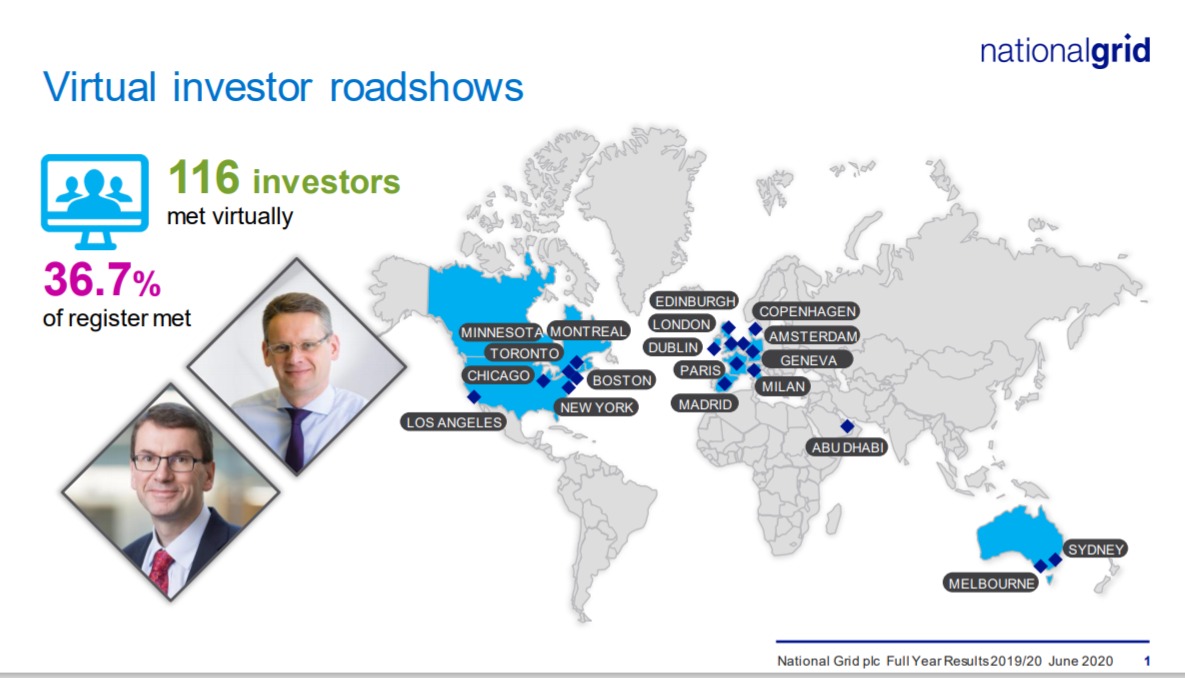For some companies, this was the year ‘virtual’ really appeared on the radar, pushed into the future as Covid-19 swept the world. Other companies – such as London-headquartered utility giant National Grid – were already on the virtual path, having taken steps to go direct with almost all investor contact as well as doing a number of meetings virtually.
Even with virtual experience under her belt, Caroline Dawson, IR manager at National Grid, tells IR Magazine that the company’s June roadshow was the first to be fully virtual – though the company is currently ‘on the road’ again.
|
Caroline Dawson, |
So what was it like to organize and hold a roadshow without ever leaving your home? For one thing, Dawson says the surge in virtual meetings as a result of Covid-19 has put some of the harder-to-reach locations – or those that require a flight for a single meeting – on the map more and really opened up the whole world in a day.
‘Now [the management team] is just used to the fact that it can have a day where it’ll speak to investors in Sydney first thing, and then speak to people in the Netherlands or Germany, for example, followed by afternoon meetings with the US,’ she says. ‘Location has become almost irrelevant.’

Source: National Grid
Giving up the day job
This ease of seeing investors regardless of location or time zone has its drawbacks. though.
‘With [senior] managers, I think it’s more difficult to get them to separate themselves from their day job,’ explains Dawson. ‘When you do a regular roadshow, they’re traveling and have to accept that they can’t run the business in the same way they usually would. When they’re doing virtual roadshows, they try to be two people at the same time. And I think that can be very exhausting and can sometimes mean they don’t get as much from their investor meetings.
‘We really learned this from June, where I tried to just give [the managers] three or four meetings a day, spread out over a two-week period. But all that really achieved was that they then did all their normal meetings as well – from 7.00 am till sometimes 8.00 pm, on the computer all day just staring at a screen.’
Meeting prep is also different when all meetings are virtual. ‘When you’re doing a physical roadshow, you have a pack that you read on the plane, you have time in the car to talk to management and you’ve got half an hour in between each meeting to discuss the previous or next meeting,’ says Dawson. ‘But now you can have lots of virtual meetings one after the other and there isn’t that same time available.’
Despite this and armed with lessons learned from June, Dawson says the current roadshow – following National Grid’s half-year results, published on November 12 – is a one-week, intense roadshow: more meetings per day but over a shorter timeframe.
Going direct
Another trend to come out of the pandemic is that more companies are going direct to the buy side. But this is something Dawson had been doing for some time using the ingage platform, which National Grid also used for its virtual roadshow. The platform has a ‘build-your-own-roadshow’ function, explains Dawson, that essentially lets you show open slots, allowing investors to voice their preferences but not automatically book out management time.
For Dawson, the importance of reaching out to investors directly has increased as a result of Covid-19, now that everyone is working from home. ‘This situation has made virtual meetings – that have been arranged directly – completely the norm,’ she says. Dawson recognizes, however, that this is perhaps somewhat easier for a company like National Grid: ‘We’re lucky: we’re a big company and generally if people are interested in the sector they will want to meet with us.’
But that doesn’t mean a bit of extra effort, or even third-party involvement, isn’t sometimes required. ‘When you’re reaching out to somebody new, it might take something a little bit more tailored,’ Dawson explains. ‘I might send an email ahead or give somebody a quick phone call. Or even [initiate contact] through a broker where appropriate.’
And while everyone in the IR and investment communities appears pleasantly surprised with how well virtual has gone this year, Dawson says that face to face is still important – particularly when trying to build a relationship. ‘It’s helpful to have met somebody at least once,’ she notes. ‘It is quite tricky to have a meaningful, ongoing dialogue with somebody you’ve never met in person. It’s not impossible and it’s going to become more normal, but I do believe it’s helpful to have met face to face.’
More meaningful feedback
As well as moving to more direct contact even before Covid-19 hit, National Grid asks investors for feedback directly because, in Dawson’s words, ‘you get far better quality and quantity’. In the past when feedback came through brokers, she says that perhaps 10 percent of investors gave feedback but that it was always anonymous and not always actionable.
‘Now, I’d say we probably get at least 50 percent of people giving feedback,’ she continues. ‘It’s pretty amazing.’ This also comes through the ingage platform but goes direct to National Grid. As well as ‘lovely feedback’ from investors saying they appreciate the company going direct rather than through a third party, Dawson says the company has just had much more feedback in general – and that it’s been a bit richer.
‘It seems [investors] are more inclined to give us that feedback direct,’ she says. ‘Whether it’s positive or negative, we want to hear what they’ve got to say.’
So what will the future of virtual look like for National Grid? Like many, Dawson says it is likely to be a split between online and physical meetings. ‘[Management] seems really pleased with how things have gone virtually and seems to be quite enjoying it. But also, the team does like traveling. And I think for both the investor and for the company, it’s still very valuable to see each other face to face,’ she says.
Another factor is the company’s US operations – with 3.5 mn customers on the electricity side and 3.7 mn on gas – so the company usually combines a US roadshow with other business activities. ‘We normally do two big roadshows per year so maybe one could be physical and the other virtual,’ says Dawson. ‘We will be smarter and more flexible when planning roadshows.’
So far, though, virtual is certainly a success. ‘In June, we saw 116 investors in two weeks from 13 different countries,’ says Dawson. ‘Compare that with a normal roadshow: I think we probably would be lucky to see half that.’











